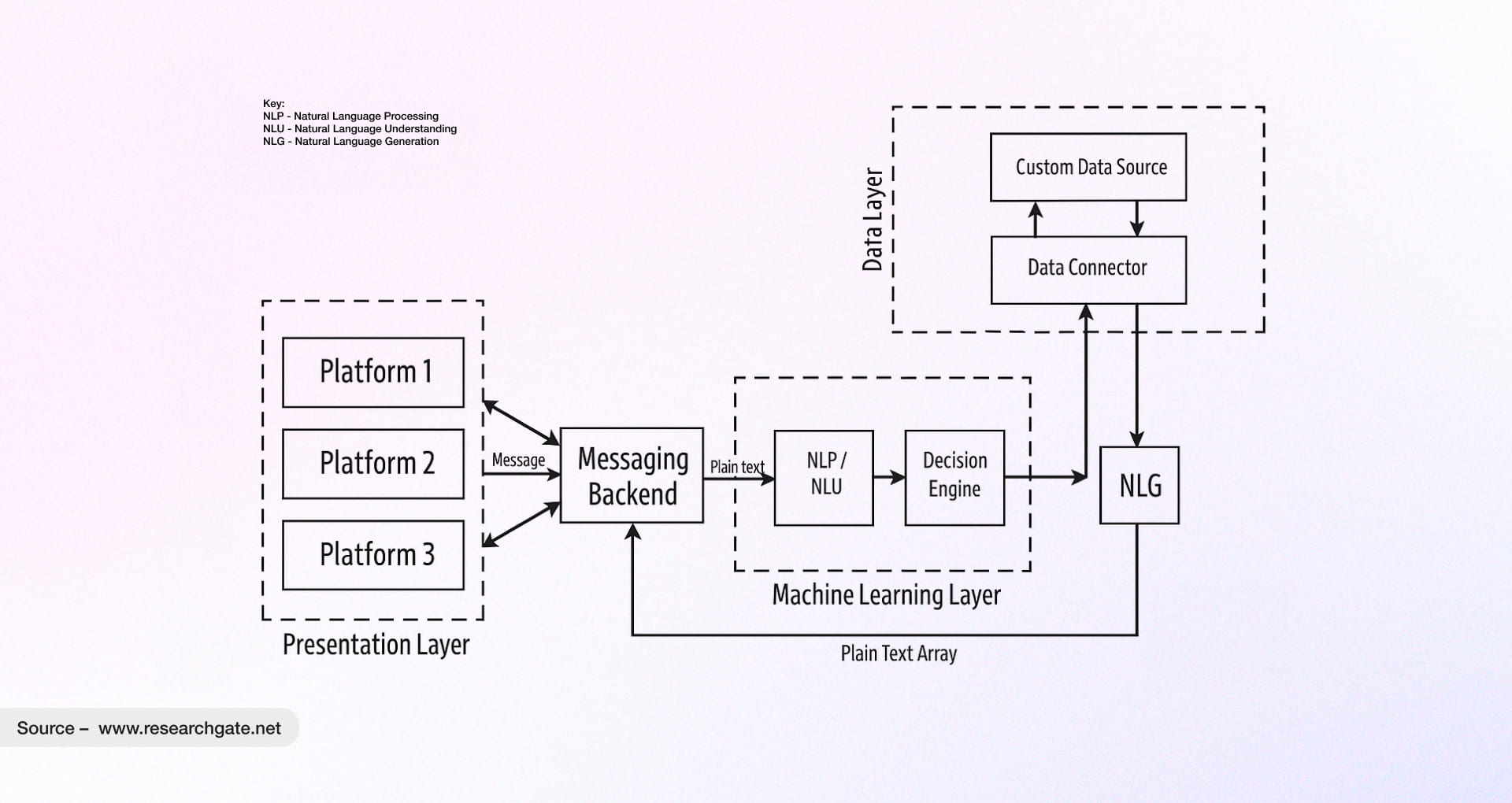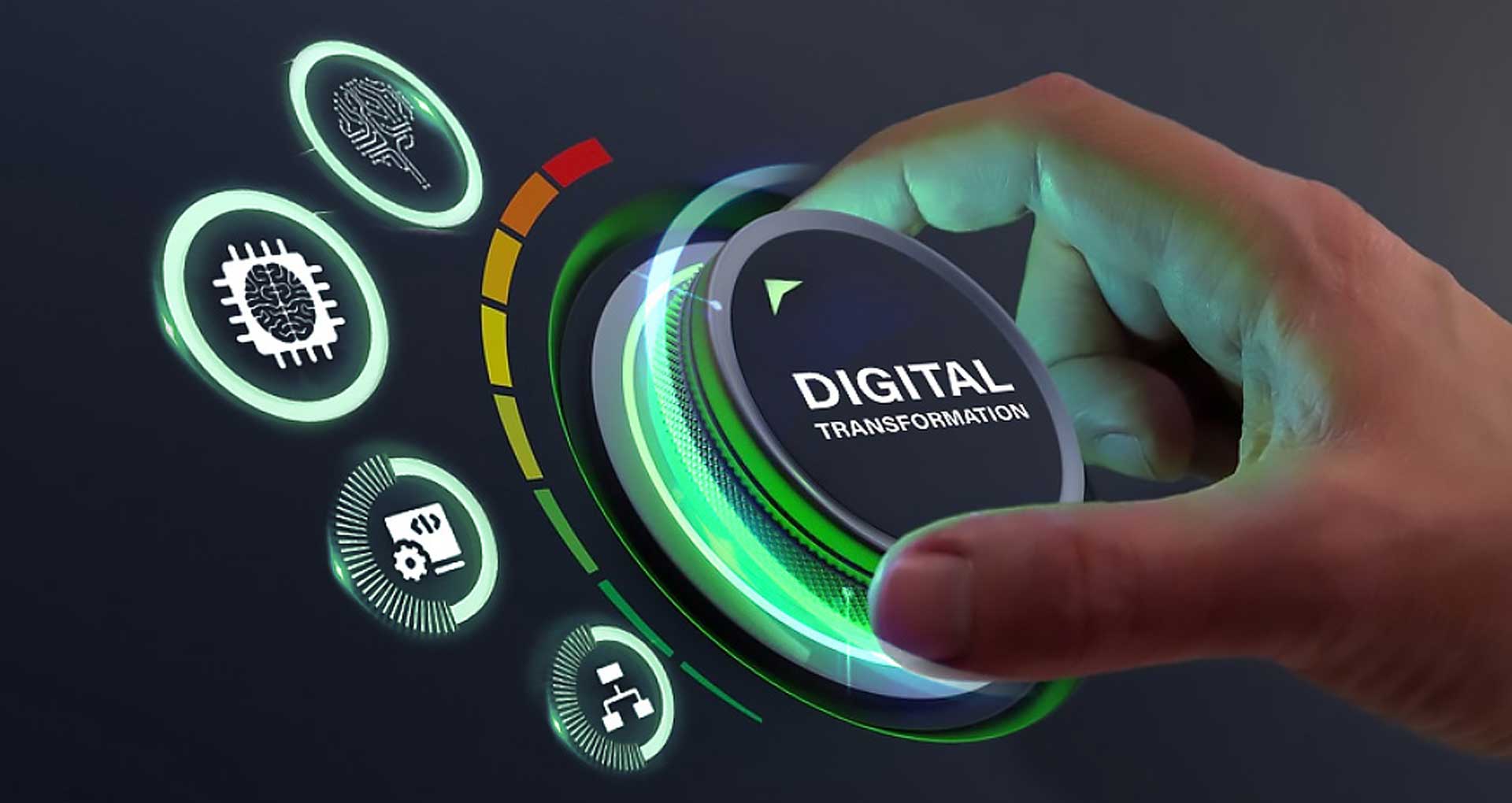In today’s experience-driven world, how your business communicates with the end user defines your brand identity and reputation. Every message, reply, and touchpoint shapes how customers feel, and those responses directly influence brand loyalty and trust. As expectations for personalized, instant, and consistent support continue to rise, business owners have realized that meaningful communication is no longer optional; it is the foundation of long-lasting relationships.
That’s where AI chatbot development steps in. AI chatbot enables always-on communication by combining human understanding with machine precision. As a result, businesses are more inclined toward embracing AI chatbot capabilities and as per research AI chatbot market is projected to grow $66.6 billion by 2033.
This informative piece of content walks you through everything you need to know, right from chatbot types and development approaches to essential features, use cases, and how Rishabh Software can help you craft a solution tailored to your business goals.
Types of AI Chatbots That Can Be Developed Using Different Technologies
AI-powered chatbot solutions come in different forms, built using different technologies, tools, and platforms. The right choice depends on your business goals, customer engagement needs, and the level of intelligence you want the chatbot to deliver.

Conversational AI Chatbots
This is the type of AI-enabled chatbot makes modern foundations even stronger. With expertise in quickly understanding intent, context, and tone, AI-enabled chatbots can provide responses that match the current situation and are ideal for smooth conversation. They analyze user messages to identify the purpose and key details, such as names, dates, and product information. The chatbot then replies using the most relevant pre-trained response or performs the requested action.
Core Technologies: Natural Language Processing (NLP) and Machine Learning (ML).
Key Capabilities:
- Understands what users mean, not just what they say.
- Maintains short-term memory to continue the conversation smoothly.
- Built with the capability to quickly detect user emotions like frustration or satisfaction.
Read More to know how customer support chatbot development redefines service experiences.
Hybrid Chatbots
Hybrid chatbots combine the efficiency of rule-based systems with the adaptability of generative AI to create more engaging and intelligent conversations. These kinds of Chatbots are designed to respond to frequently asked queries and predefined responses. However, whenever users submit new queries, the system switches to a generative AI model to deliver better and instant resolution.
Value: This blend ensures businesses get the best of both worlds, accuracy for routine tasks and flexibility when conversations get complex.

Generative AI Chatbots
This term has been bouncing around us for many years, like ChatGPT and Gemini, which represent the most advanced level of generative AI chatbot (a subset of AI technology or capabilities). Just like other types of AI chatbots, this one works by selecting pre-written answers; it generates original, human-like responses using deep learning and massive datasets.
Key Capabilities
- Engage in natural, dynamic, and multi-turn conversations.
- Generate diverse content such as summaries, explanations, or code.
- Apply reasoning using extensive general and contextual knowledge
Tech Enhancement: When integrated with enterprise data using RAG (Retrieval-Augmented Generation), they provide accurate, business-aligned, and domain-specific responses.
Transactional Chatbots (Task-Oriented)
These chatbots are designed to perform specific or highly repetitive operations. The sole purpose is to simplify tasks by providing a smooth, efficient experience for end users. They guide users step by step through a defined process, such as booking a ticket, placing an order, or resetting a password. Transactional chatbots are often integrated with internal systems via APIs to complete the task.
Core Technologies: Natural Language Understanding (NLU), Knowledge Graphs & AI Reasoning Engines
Voice Assistants and Voice Bots
Voice-based AI systems let users interact via spoken commands rather than typing. The user will command that system, and they will follow the instructions. Siri, Alexa, and Google Assistant are the best examples that have undoubtedly turned into our daily lives.
Core Technologies: Automatic Speech Recognition (ASR) converts voice to text, while Text-to-Speech (TTS) turns responses into natural audio. The conversation logic is powered by contextual or generative AI.
Multimodal Chatbots
Such chatbots represent the next generation of intelligent assistants, capable of understanding and responding to multiple input types, including text, voice, images, and even documents.
A multimodal AI chatbot can analyze an image (“What’s in this photo?”), read a PDF, or respond with visuals or text, depending on the query, where other AI chatbots may lack the expertise or ability.

If we talk about the quick example, then Retail (visual search), education (interactive learning), and technical support (image-based troubleshooting).
Core Technologies: Advanced AI models that combine language, vision, and sound processing to create a single intelligent response.
How to Develop an AI Chatbot?
AI-powered chatbot development focuses on building a custom solution that automates customer service while keeping the customer at the center. It can serve multiple purposes, acting as a helpdesk for customers, a lead magnet, and a sales ally, all aligned with your vision. Let us walk you through the steps to develop an AI chatbot.
- Identify the Purpose and Define the Use Case: To create foolproof strategies for your AI chatbot development, start by asking the questions that matter: What are you building? Who are you building it for? When does it add real value? And why does it even need to exist? Get clarity for below listed questions.
- Why do you want this chatbot to assist, to sell, or to simplify?
- Who will actually talk to it, customers, employees, or prospects?
- Does it truly serve your business purpose, or is it just noise in your tech stack?
Every answer you define here shapes not just your chatbot’s logic, but its legacy.
Action Strategic Focus Why It Matters Pinch Point Analysis Identify the top 3–5 repetitive and costly customer interactions (e.g., password reset, order tracking). Ensures the chatbot targets high-impact pain points and delivers measurable cost savings. KPI Definition Define metrics such as Containment Rate (queries resolved by the bot) and Escalation Rate (queries requiring human support). Links chatbot performance directly to business outcomes and service quality. Data Inventory List required data sources (CRM, ERP, Knowledge Base) and key communication channels (web, mobile app, social, or chat platforms). Defines integration needs, data dependencies, and security requirements early on.
- Choose the Right Type and Technology: When it comes to AI chatbot development, your technology stack is where intelligence meets infrastructure. It defines how your chatbot thinks, learns, and responds, and more importantly, how it scales with your business. Choosing the right architecture and tools can be the most strategic move for long-term scalability of your chatbot.
Key Actions to Focus On:- Select Core Architecture: Choose what powers your AI chatbot, like intent-based for accuracy, generative for natural flow, or hybrid for balanced intelligence and reliability.

Source: Researchgate.net - Platform Selection: Go with managed platforms like Dialogflow for speed, or frameworks like Rasa for flexibility and control.
- Security Layer: Secure every interaction with strong access controls and authentication. Trust is the first feature your chatbot should have.
- Design the Conversation Flow and Train the Model: This step is all about aligning your future AI chatbot with your brand and operations. It involves defining how you communicate, what you communicate, and how you utilize operational data effectively. This is also the stage where you train your model on factors such as user behavior, intent, and context to make interactions more meaningful and brand-consistent.
What to Prioritize:- Data Curation & Labeling: Gather historical chat logs or support tickets. Label utterances, intents, and entities with accuracy because well-labeled data drives stronger NLP precision.
- Conversation Design Mapping: Map conversation paths for every use case. Add fallback options (for example, “Would you like to connect to a support agent?”) to maintain flow when the bot’s confidence dips.
- Confidence Thresholds: Define a minimum confidence score (for instance, 0.70). Below that, ensure the chatbot hands off to a human or activates a generative fallback to keep the experience seamless.
- Develop, Integrate, and Test: This is where the ideas and strategy part meet execution. Build what you’ve exactly imagined, but build it smart. Before going all in, ensure your chatbot performs flawlessly at a smaller scale (build MVP).
Development Best Practices:- Iterative MVP Development: Start small, deploy fast, and let real conversations guide your improvements.
- Comprehensive Testing: Run every possible test, like integration, load, and regression, because one broken API can break trust.
- User Acceptance Testing (UAT): Let a handful of real users talk to your bot. Their confusion, hesitation, or delight will tell you everything data can’t.
- Version Control & Draft Mode: Keep track of every tweak, every iteration. Test new updates in a sandbox before they meet the world.
- Deploy, Monitor, and Continuously Improve: You are close to launching your AI chatbot development project. After building it effectively, ensure seamless deployment by measuring key factors that have an impact during launch.Take a proactive and agile approach, ensure ongoing efforts, and aim to stand out while balancing every element for consistent performance. Create a feedback-driven system for continuous learning and performance improvement.
Action Strategic Focus Why It Matters Phased Rollout Launch to a small audience or a single channel first. Minimizes risk and allows faster refinement from real-world data. Monitor Low-Confidence Logs Review interactions where AI confidence was low or where users escalated to human agents. Pinpoints areas for retraining and optimization. Human-in-the-Loop (HITL) Have human reviewers correct failed logs and re-feed them into training datasets. Creates a closed learning loop, the chatbot continuously evolves with real-world data, previous conversations.
You can expect a continuously evolving, AI-driven chatbot that learns on its own, communicates intelligently, understands user pain points, and delivers accurate, instant responses.
Must-Have Features of an AI-Powered Chatbot
Building an AI chatbot is more than just a rule-based conversation system/solution. It is about designing an experience that listens, understands, and solves. People do not want robotic replies in the modern era. They want quick and meaningful help. Here is what separates an average chatbot from a great one.
Understands Real Language
The best chatbots do not just read words. They understand the meaning. When someone says, “I cannot find my order,” the bot should get it. No scripts, no confusion, but a relevant reply that moves things forward.
Remembers Past Conversations
Nobody likes repeating the same thing again and again. A good AI-enabled chatbot remembers who you are and what you talked about. It turns a mechanical chat into a personal experience.
Works Everywhere
Your users might text from a website, mobile app, or social platforms. The chatbot should meet them there. Consistency is not a feature; it is the baseline of good communication & engagement.
Speaks the Customer’s Language
People connect when they feel understood. A multilingual chatbot does not just translate words; it bridges comfort. It makes users feel seen, not processed.
Finds Answers Fast
It connects directly to verified data, your FAQs, CRM, or product database, and gives accurate answers right away. No waiting. No wandering.
Understands Emotion
A frustrated customer does not need fancy responses. They need empathy. A smart chatbot can sense tone and respond with patience instead of cold precision.
Learns From Every Chat
Every conversation teaches something. The chatbot should learn, adapt, and respond better next time. That is how technology becomes intelligent by paying attention.
Handles Voice and Visuals
Sometimes typing feels slow. People might want to talk or share a photo. A chatbot that listens or looks can solve faster and make help feel effortless.
Keeps Data Safe
Trust is invisible but powerful. Every message, every click must be secure. When users share information, they should never wonder where it goes.
Tracks Its Own Performance
A confident & self-learning AI chatbot checks itself. It measures how fast it replies, how many questions it solves, and when it falls short. Numbers tell the truth, and truth drives improvement.
AI Chatbot Use Cases by Industry
Wondering if your industry should adopt it and how efficiently it can unlock customer-facing engagement, build trust, and deliver satisfaction in every conversation? Here are the ways various industries can leverage AI chatbots across their verticals.
HealthTech
Chatbots in healthcare are quietly changing how people experience personalized and engaging interactions. They make it easier to reach doctors, get information, and stay on top of care routines. A study by NYU Langone Health found that an AI tool drafted responses to patients’ EHR queries with accuracy and empathy comparable to those of human clinicians. Here are the key use cases of AI chatbot in healthcare industry:
- Book or reschedule appointments in seconds.
- Check symptoms and get guidance before visiting a doctor.
- Receive timely reminders for medicines or follow-ups.
- Access lab reports and discharge summaries instantly.
- Offer 24/7 wellness tips or mental health support when no one else is around.
Read our blog on Healthcare Bot Development!
FinTech
In finance, speed is an attribute that aligns things, like building trust and staying connected with customers. Banking AI chatbots make complex tasks simple, clear, and instant. Bank of America’s chatbot “Erica”, handles balance inquiries, transactions, proactive alerts, and more via mobile banking.
- Provide account balance updates and recent transaction details.
- Help customers activate cards, reset PINs, or track loan applications.
- Detect unusual activity and alert users immediately.
- Share spending insights or budgeting suggestions.
- Explain financial products in plain and easy-to-understand language.
Read our blog on Banking Bot Development!
Retail
Online shoppers expect quick answers and personal attention. AI chatbots deliver both, right when it matters. If we talk about the example, Sephora is best. Its “Virtual Artist” chatbot uses AI to help customers try on makeup virtually, get style suggestions, and checkout assistance.
- Recommend products based on browsing habits or past purchases.
- Answer stock, price, and delivery questions instantly.
- Remind users about abandoned carts or ongoing offers.
- Help with exchanges, returns, and refund updates.
- Manage loyalty programs and reward point balances.
Digital Manufacturing
AI chatbots keep teams informed, connected, and in control. Manufacturing industries are going ahead to leverage the AI chatbot benefits. Stellantis in partnership with Mistral AI, announced a chatbot powered by Mistral AI that interacts with BOM (bill of materials) data to help engineers streamline component selection and reuse
- Share production line updates or maintenance schedules in real time.
- Alert supervisors about delays or equipment issues.
- Help technicians troubleshoot with guided responses.
- Track shipments and supply chain movements.
- Generate quick reports on performance or inventory levels.
Insurance
AI chatbots in insurance can read documents, detect fraud, and connect insights across systems, transforming claims, underwriting, and customer interactions into faster and smarter experiences.
- Guide customers in choosing the right policy.
- Auto Insurance Policy Selection and Management
- Help with claim filing, document uploads, and status updates.
- Send payment and renewal reminders automatically.
- Answer coverage-related questions at any hour.
- Support agents by handling repetitive, low-value tasks.
Read our latest blog on AI Agents in Insurance!
Partner with Rishabh Software to Build Your Custom AI-powered Chatbot
As a prominent AI agent development company, we bring practice-proven expertise for your business. With a genuine understanding of how AI really works, we integrate and build a value-driven solution. We’ve got a solid grasp of the emerging technologies and know precisely what it takes to transform complex algorithms into meaningful conversations that drive business growth.
Our approach is simple yet powerful. We build chatbots that feel relatable, not robotic. Every solution we create blends human-like interaction with real business intent, ensuring your brand connects, engages, and delivers value in every conversation.
Frequently Asked Questions On AI Chatbot Development
Q. What Is AI Chatbot Development?
A. It’s the process of creating intelligent virtual assistants that understand, learn, and respond like humans while simplifying communication for your business.
Q. What Is An AI Chatbot?
A. An AI chatbot could be a solution, tool, or platform that empowers businesses to operate in an auto-pilot mode across customer touchpoints, delivering accurate and automated responses using advanced machine intelligence.
Q. What Factors Affect AI Chatbot Development Cost?
A. The cost depends on complexity, integrations, technology stack, and customization. In short, how smart and feature-rich AI-chatbot you are planning to build for your business.
Q. What Are The Key Benefits of An AI Chatbot?
A. AI chatbots provide instant support, work 24×7, lower support costs, improve engagement, handle large volumes easily, offer consistent answers, and help generate qualified leads.
Q. What Are The Latest AI Chatbot Trends?
A. From voice-enabled bots and generative AI models to hyper-personalized conversations, chatbots are now evolving from assistants to decision-makers. Here are the emerging AI infused chatbot development trends that can be expected in 2026.
- Agentic AI Chatbots
- Multimodal Conversational Agents
- Predictive & Proactive Chatbot Intelligence
- Emotionally-Aware Conversational Systems
- Domain-Specialized Chatbot Ecosystems
- Low-Code / No-Code Chatbot Builders
- Ethical & Compliant AI Chatbot Architectures
- Human-AI Collaborative Service Bots
- Embedded Chatbots in Vertical Workflows
- Conversational Commerce & AI-Sales Agents











 30 Min
30 Min


